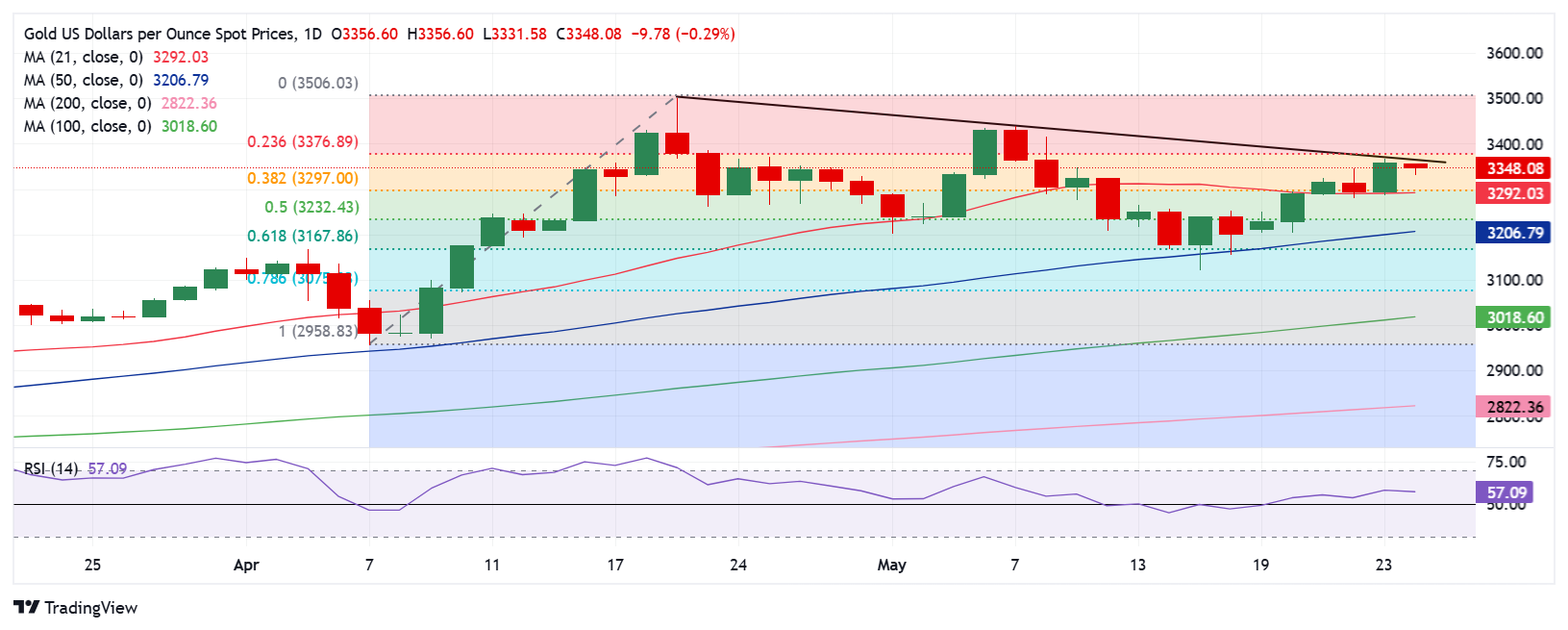- Gold price pulls back from two-week highs early Monday.
- The US Dollar ignores Trump’s extension of EU tariff deadline as fiscal concerns haunt.
- Gold price runs into stiff resistance at $3,364; RSI stays bullish on the daily chart.
Gold price is on a tepid retreat from two-week highs of $3,365 hit on Friday as buyers take a breather amid holiday-thinned conditions on Monday.
Gold price down but not out in the US inflation week
US President Donald Trump’s walking back on his earlier threat of a 50% tariff on the European Union (EU) from June 1 and announcing a July 9 deadline extension fails to provide any respite for the US Dollar (USD).
The Greenback refreshes multi-week lows against its major currency rivals, with the US Dollar Index (DXY) losing about 0.40% on the day to trade near 98.70, as of writing.
Despite the sustained US Dollar weakness, Gold price has come under renewed selling pressure as markets weigh in a likely trade deal between the US and Japan by mid-June.
Japanese Prime Minister Shigeru Ishiba said on Sunday that he aims to achieve a trade agreement with the US during the Group of Seven (G7) Summit on June 15.
However, any downside in Gold price appears limited as looming US fiscal concerns and escalating geopolitical tensions will continue to power safe-haven demand for the bright metal.
Ukrainian President Volodymyr Zelenskyy stated early Sunday that Russian missiles and drones hit more than 30 cities and villages across Ukraine and urged Western partners to ramp up sanctions on Russia.
Meanwhile, Iranian Foreign Minister Abbas Araghchi said last week that discussions with the US over its nuclear program were ‘complicated’ as the fifth round of talks concluded in Rome.
Last week, the US House of Representatives passed Trump’s expansive tax and spending bill, which is expected to widen the nation’s $36 trillion national debt.
Markets also remain wary of Trump’s latest tariff threats targeting Apple Inc. Trump warned Apple on Friday that he would impose a 25% import tax “at least” on iPhones not manufactured in America, later widening the threat to any smartphone.
In the day ahead, Gold price could see a limited pullback but light trading conditions could exaggerate moves as the US markets are closed on Monday, in observance of Memorial Day.
A mild profit-booking decline cannot be ruled out though as traders gear up for the US inflation data due later this week. Trade headlines will continue to drive the Gold price action.
Gold price technical analysis: Daily chart

Technically, Gold price remains exposed to further upside as the 14-day Relative Strength Index (RSI) holds comfortable above the midline, near 57, despite the latest downtick.
If buyers fight back control, a sustained break above the falling trendline resistance at $3,364 is needed to resume the ongoing uptrend.
The next topside barriers are aligned at $3,400 (round level) and $3,435 (static resistance).
On the downside, strong support is seen near $3,295, which is the confluence of the 21-day Simple Moving Average (SMA) and the 38.2% Fibonacci Retracement (Fibo) level of the April record rally.
If the corrective move intensifies, a test of the 50% Fibo support at $3,232 will be inevitable, below which the 50-day SMA at $3,207 will come into play.
Gold FAQs
Gold has played a key role in human’s history as it has been widely used as a store of value and medium of exchange. Currently, apart from its shine and usage for jewelry, the precious metal is widely seen as a safe-haven asset, meaning that it is considered a good investment during turbulent times. Gold is also widely seen as a hedge against inflation and against depreciating currencies as it doesn’t rely on any specific issuer or government.
Central banks are the biggest Gold holders. In their aim to support their currencies in turbulent times, central banks tend to diversify their reserves and buy Gold to improve the perceived strength of the economy and the currency. High Gold reserves can be a source of trust for a country’s solvency. Central banks added 1,136 tonnes of Gold worth around $70 billion to their reserves in 2022, according to data from the World Gold Council. This is the highest yearly purchase since records began. Central banks from emerging economies such as China, India and Turkey are quickly increasing their Gold reserves.
Gold has an inverse correlation with the US Dollar and US Treasuries, which are both major reserve and safe-haven assets. When the Dollar depreciates, Gold tends to rise, enabling investors and central banks to diversify their assets in turbulent times. Gold is also inversely correlated with risk assets. A rally in the stock market tends to weaken Gold price, while sell-offs in riskier markets tend to favor the precious metal.
The price can move due to a wide range of factors. Geopolitical instability or fears of a deep recession can quickly make Gold price escalate due to its safe-haven status. As a yield-less asset, Gold tends to rise with lower interest rates, while higher cost of money usually weighs down on the yellow metal. Still, most moves depend on how the US Dollar (USD) behaves as the asset is priced in dollars (XAU/USD). A strong Dollar tends to keep the price of Gold controlled, whereas a weaker Dollar is likely to push Gold prices up.







